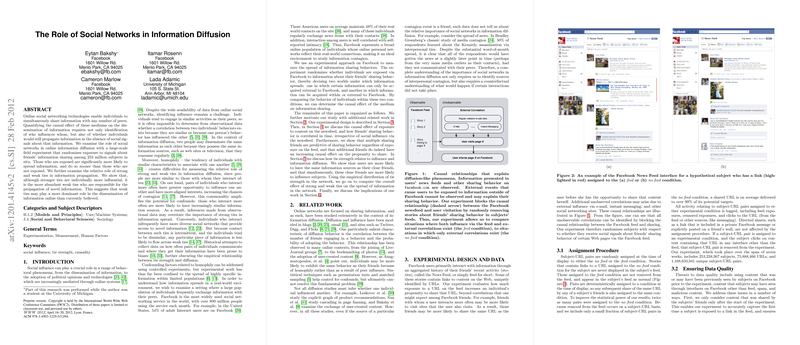The Role of Social Networks in Information Diffusion
The paper "The Role of Social Networks in Information Diffusion" by Eytan Bakshy, Itamar Rosenn, Cameron Marlow, and Lada Adamic presents a comprehensive paper on the influence of online social networks on information dissemination. Conducting a large-scale field experiment utilizing Facebook, the researchers quantified the effect of network exposure on the propagation of shared information.
Summary of Key Findings
The experiment encompassed 253 million Facebook users and investigated how exposure to friends' sharing behaviors influenced participants' likelihood to share the same content. The primary findings can be summarized as follows:
- Increased Likelihood of Sharing: Users exposed to their friends' shared links on Facebook's newsfeed were significantly more likely to share those links themselves. Specifically, the paper found that individuals in the feed condition were 7.37 times more likely to share compared to those not exposed ( CI = ).
- Temporal Clustering: Users who shared the same link as their friends generally did so within a proximate timeframe, underscoring the impact of temporal clustering. Users in the feed condition shared a link within a median time of six hours of exposure, versus twenty hours for those in the no feed condition.
- Effect of Multiple Sharing Friends: The probability of a user sharing content increased with the number of friends who had previously shared the same link. Moreover, while the relative risk ratio declines as the number of sharing friends increases, indicative of information redundancy and diminished incremental influence.
- Tie Strength and Influence: While strong ties (measured through various interaction frequencies) were individually more influential in information spread, weak ties, due to their abundance, played a pivotal role in the diffusion of novel information. The experiment showed that weak ties propagated most shared content overall, highlighting their systemic impact.
Methodology
The experimental design involved randomly assigning user-URL pairs to either the feed or no feed conditions. The feed condition allowed participants to see their friends' sharing behavior in their newsfeeds, while the no feed condition blocked such visibility. This random assignment facilitated a causal measurement of the influence of social networks on information sharing, addressing potential confounding factors such as homophily.
Implications
Practical Implications
The findings have direct applications in the design of social media platforms and marketing strategies. Understanding the pronounced role of weak ties and the accelerated spread of information via multiple sharing friends can aid in crafting more effective content distribution strategies, harnessing the systemic influence dynamics identified.
Theoretical Implications
The paper extends existing theories about social networks by providing empirical evidence attesting to Granovetter's "strength of weak ties" hypothesis in the digital age. The result shows that while strong ties have a higher individual impact due to trust and frequent interaction, weak ties are essential for broad information dissemination due to their greater reach and diversity in unfamiliar information.
Future Research
This paper paves the way for further exploration of information diffusion across different social networks and varying types of content. Future research might investigate the nuances of demographic variables such as age, nationality, and their influence on information diffusion. Additionally, understanding the differential impacts of various content types—ranging from news articles to multimedia—will offer deeper insights into optimizing information propagation in social networks.
Conclusion
"The Role of Social Networks in Information Diffusion" offers a meticulous investigation into how information spreads across social networks. It sheds light on the mechanics behind sharing behavior, emphasizing the crucial influence of exposure and social ties. The implications for both practical applications and theoretical advancements in network science and social media research are profound, making this paper an essential reference for scholars and practitioners alike.
